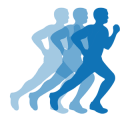Tight calf muscles at the back of the lower leg are a common problem in athletes, especially those who run long distances.
What are the calf muscles?
The calf muscles consist of the gastrocnemius muscle and the soleus muscle.
Gastrocnemius
The gastrocnemius muscle, the larger of the two muscles, originates above the back of the knee and attaches to the back of the heel through the Achilles tendon.
To stretch the gastrocnemius muscle, maintain a straight knee position.
Soleus
The deeper soleus muscle originates below the knee and attaches to the back of the heel. To stretch the soleus muscle, it is necessary to bend the knee.
Have I got tight calf muscles?
Tight calf muscles can be identified by progressive tightening over time. This tightness may worsen during running or temporarily improve during running but then return later.
Palpation of the muscles may reveal the presence of firm or nodular areas, indicating tightness or spasms where muscle fibres have constricted. These areas will be painful and tender upon touch.
Soleus muscle assessment
Soleus muscle flexibility is measured with your knee bent.
What causes tight calf muscles?
Tight calf muscles may stem from a variety of factors, including:
Lack of stretching: Insufficient pre- and post-training stretching can lead to the gradual development of tightness. Micro-tears in the muscles result in spasms, impeding proper blood flow.
Adaptive shortening: Infrequent stretching can cause adaptive shortening, and one common cause of tight calf muscles is regular high heel use, which contributes to muscle shortening.
Foot biomechanics: Biomechanical issues in foot function or running style can increase strain on the calf muscles. Overpronation, where the foot excessively rolls inward or flattens, leads to repetitive strain and overuse. Gait analysis on a treadmill can detect such issues, and orthotic inserts may be prescribed to address them.
Compartment syndrome: Compartment syndrome can also contribute to tight calf muscles, though further explanation is required for a complete understanding.
How do I improve calf flexibility?
Improving calf flexibility is a process that requires consistent effort and the right approach. Here, we explore various strategies you can use to enhance flexibility, prevent muscle tightness, and ultimately improve your overall health and performance.
Strengthening Your Muscle Flexibility
Prioritise incorporating calf muscle stretching exercises into your daily routine. Consistently doing this over a period of at least six weeks can significantly enhance your muscle flexibility.
Enlisting Help from a Sports Therapist
Engage the services of a sports therapist for deep tissue massages. The frequency of your visits should correspond with the severity of your condition. Strive to avoid extensive gaps between treatments to retain the benefits gained.
Night-time Practices
Incorporate the use of a plantar fasciitis night splint while you sleep. While it may take time to adapt to this addition, it’s highly beneficial in preventing muscle tightness and promoting calf flexibility.
Inclusion of a Calf Stretcher
Adding a calf stretcher to your routine can also be highly beneficial. Different types serve different purposes. A slant board calf stretcher, for instance, allows for a systematic approach to stretching and tracking your progress. On the other hand, a rocker-type calf stretcher provides a deeper stretch.
Why do I stretch but seem to get nowhere?
Implementing Correct Stretching Methods:
For effective stretching, avoid using excessive force which can lead to muscle contraction. Stretch your muscles gently without bouncing. Increase the intensity progressively for optimal muscle elongation.
Experiencing Unilateral Tightness:
Do you feel a persistent tightness in one leg? This could be a sign of sciatic nerve pressure. Don’t hesitate to consult a professional for a thorough evaluation.
Running-Related Pain and Tightness:
If you notice pain or tightness while running that subsides upon rest, you might be dealing with compartment syndrome. This condition warrants careful consideration and potential intervention.
Preventing Overnight Calf Tightness:
Tight calves in the morning? Consider using a plantar fasciitis night splint. This device, worn during sleep, has proven effective in preventing overnight calf tightness.
Sports massage for tight calf muscles
With the goal of relaxing muscles, boosting flexibility, and improving muscle condition, sports massage is a vital tool for athletes.
Therapists, prior to initiating the massage, ensure its compatibility by checking contraindications. Thus, sports massage effectively alleviates muscle tension, enhances circulation, and aids in healing.

